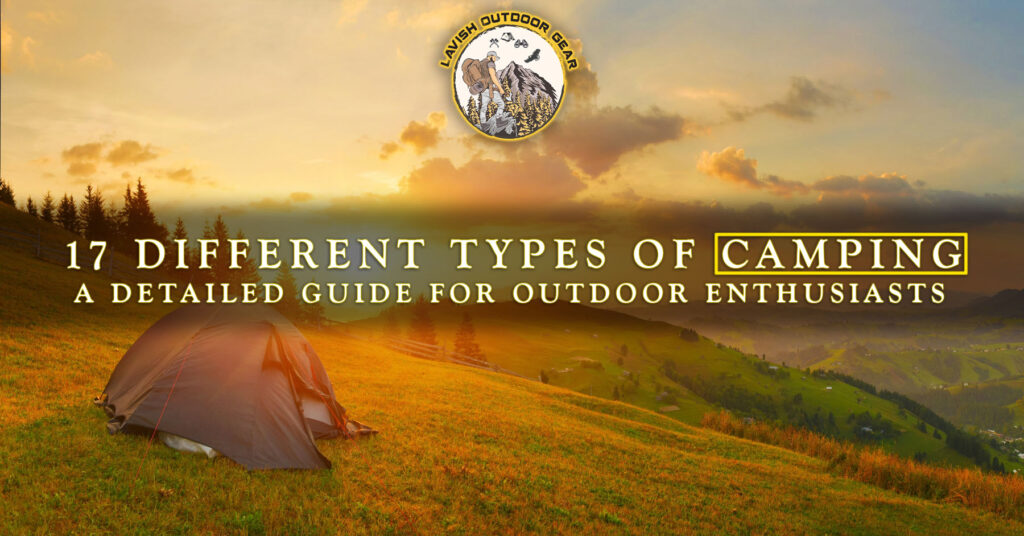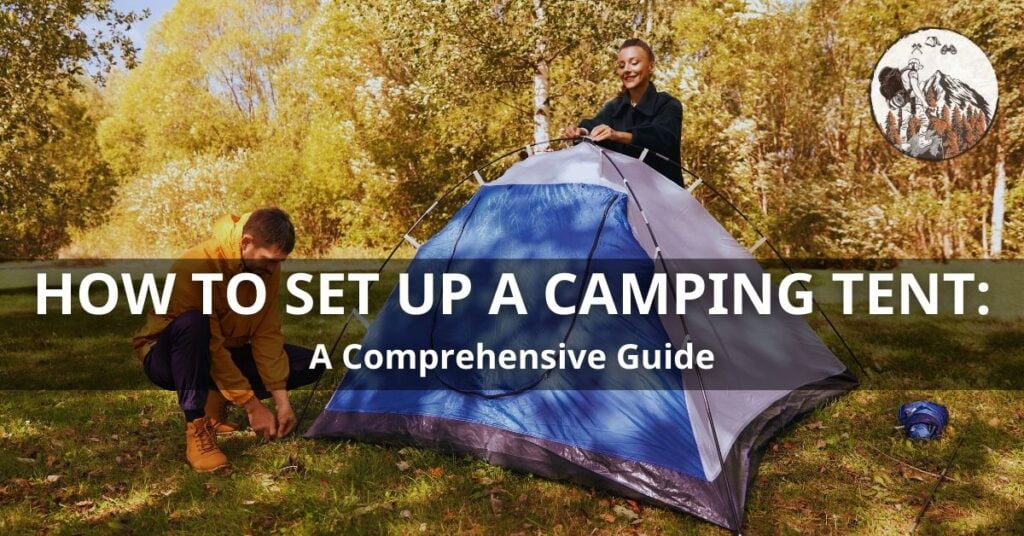Crisp, fresh air. The crackling of a campfire. The embrace of nature. Camping is a cherished activity that allows us to disconnect from the digital world and reconnect with the great outdoors. But did you know that there are different types of camping to suit different preferences and adventure levels?
In this comprehensive guide, we’ll explore the various types of camping, equip you with essential knowledge, and inspire you to embark on your next outdoor adventure. Additionally, we’ll discuss how to choose the right type of camping for your individual needs, preferences, and budget. Moreover, we have an in-depth guide on “12 Different Types of Tents for Camping“.
The popularity of camping
Camping has grown in popularity over the years, with more and more people seeking to spend time in the great outdoors. In fact, according to the 2020 North American Camping Report, over 50 million households in the United States and Canada participated in camping activities in 2019, with 77% of campers stating that they plan to camp the same or more in the future.
Also in 2021, according to the North American Camping Report, more than 93.8 million North American households considered themselves campers.
Table of Contents
Let’s Explore Different Types of Camping

1. Tent Camping: Exploring the Great Outdoors
Tent camping is one of the most popular forms of camping, and for good reason. It offers an affordable and immersive way to experience the great outdoors while enjoying the comforts of home.
Definition and explanation
Tent camping involves setting up a tent in a designated campsite or wilderness area and spending one or more nights outdoors. It typically involves minimal amenities, with campers cooking their meals over a campfire or portable stove and using public restrooms or digging a hole to go to the bathroom.
Gear needed for tent camping
It’s important to have the right gear for tent camping. Here are some essential items to bring on your trip:
- Tent: Choose a tent that fits your needs based on size, seasonality, and weather conditions.
- Sleeping bags and pads: Invest in quality sleeping bags and pads to keep you warm and comfortable during the night.
- Cooking supplies: Bring a portable stove, cooking utensils, plates, cups, and utensils to make meals.
- Food and water: Plan and bring enough food and water for your trip, and bring a water filter or purification tablets in case of emergencies.
- Clothing and footwear: Dress appropriately for the weather and bring sturdy, comfortable footwear for hiking and exploring.
- First aid kit: Bring a basic first aid kit to address minor injuries or illnesses.
- Other necessary supplies: Include a headlamp or flashlight, insect repellent, sunscreen, and a multi-purpose tool.
Pros and cons
Pros:
- Nature connection and stress relief
- Affordable and accessible
- Sense of adventure and excitement
Cons:
- Limited amenities and comfort
- Exposure to extreme weather conditions
- Requires preparation and planning
Tips for tent camping
Here are some guidelines to ensure a successful tent camping experience:
- Before your camping trip, conduct research on your campsite and create a checklist of essential items to pack.
- Practice setting up and taking down your tent before your trip to avoid any difficulties.
- Pack extra layers of clothing to stay warm and be prepared for unpredictable weather changes.
- Adhere to Leave No Trace principles and leave the campsite cleaner than you found it.
- Bring a backup plan or additional supplies to deal with any unexpected weather or challenges.
Tent camping can be a rewarding and exciting way to experience the great outdoors, as long as you come prepared and approach it with a sense of adventure. With the right gear, knowledge, and attitude, tent camping can be a life-changing experience that you’ll never forget.

2. Backpacking: Exploring the Great Outdoors on Foot
Backpacking is a form of camping that involves carrying all necessary gear and supplies in a backpack and hiking to a remote location to set up camp.
Definition and explanation
Backpacking involves carrying everything you need to survive in the wilderness on your back, including food, shelter, and clothing. It typically involves hiking to a remote location and spending one or more nights outdoors. Backpacking is often done on designated trails or in wilderness areas and requires a high level of physical fitness and outdoor skills.
Gear needed for backpacking
Backpacking can be enjoyable and safe if you have the right gear. If you’re going on a trip, make sure to pack the following items:
- Backpack: Choose a backpack that fits your body and your gear, and adjust it to distribute weight evenly.
- Tent: Choose a lightweight, durable tent that is appropriate for the season and weather conditions.
- Sleeping bag and pad: Invest in quality, lightweight sleeping gear to keep you warm and comfortable during the night.
- Cooking supplies: Bring a lightweight stove, cooking utensils, plates, cups, and utensils to make meals.
- Food and water: Plan and bring enough lightweight, non-perishable food and water for your trip, and bring a water filter or purification tablets in case of emergencies.
- Clothing and footwear: Dress in layers appropriate for the weather and bring sturdy, comfortable footwear for hiking and exploring.
- First aid kit: Bring a comprehensive first aid kit to address injuries or illnesses in the wilderness.
- Other necessary supplies: Include a headlamp or flashlight, map and compass, insect repellent, sunscreen, and a multi-purpose tool.
Pros and cons
Backpacking has its advantages and disadvantages as follows:
Pros:
- Experiential learning and stress relief
- Sense of adventure and self-reliance
- Exercise and fitness improvement
Cons:
- Outdoor skills are required
- Exposure to unpredictable weather and wildlife
- Limited amenities and comfort
Tips for backpacking
Some tips for a successful backpacking trip are here:
- Research your trail and campsite ahead of time and make a checklist of the necessary items to pack.
- Practice packing and adjusting your backpack before your trip.
- Bring extra layers of clothing and rain gear to stay warm and dry in changing weather conditions.
- Leave no trace by following Leave No Trace principles and carrying out all trash.
- Be prepared for unexpected weather or challenges by bringing a backup plan or additional supplies.
Backpacking can be a challenging and rewarding way to experience the great outdoors, as long as you come prepared and approach it with a sense of adventure. With the right gear, knowledge, and attitude, backpacking can be a life-changing experience.

3. Bikepacking: Exploring the Great Outdoors on Two Wheels
Bikepacking is a form of adventure cycling that involves carrying all necessary gear and supplies on a bicycle and riding to a remote location to camp.
Definition and explanation:
Bikepacking is a unique way to explore the great outdoors that combines the physical challenge of cycling with the freedom of self-supported travel. Instead of relying on motorized vehicles, bikepackers use bicycles to carry their gear, food, and shelter.
Bikepacking can be done on any kind of bike, from a mountain bike to a road bike, and typically involves riding on unpaved roads or trails to reach remote destinations for camping.
Gear needed for bikepacking:
Bikepacking requires a different set of gear than traditional backpacking, including the following:
- Bike: Choose a sturdy, reliable bike that is appropriate for the terrain and distance of your trip
- Bags: Invest in a set of bike bags that can be attached to your bike frame, handlebars, and seat post to carry your gear.
- Tent or shelter: Make sure the tent or hammock you choose is lightweight, durable, and easy to set up.
- Sleeping bag and pad: Bring a quality, lightweight sleeping bag, and pad to keep you warm and comfortable during the night.
- Cooking supplies: Bring a compact stove, cooking utensils, plates, cups, and utensils to make meals.
- Food and water: Plan and bring enough lightweight, non-perishable food and water for your trip, and bring a water filter or purification tablets in case of emergencies.
- Clothing and footwear: Dress in layers appropriate for the weather and bring sturdy, comfortable footwear for cycling and hiking.
- First aid kit: Bring a comprehensive first aid kit to address injuries or illnesses on the road.
- Other Important Supplies: You’ll also need a headlamp or flashlight, a map, a compass, insect repellent, sunscreen, and a multipurpose tool.
Pros and cons:
Bikepacking has its advantages and disadvantages as follows:
Pros:
- See remote areas and beautiful landscapes that may be inaccessible by car or foot
- Sense of adventure and self-reliance
- Physical exercise and a chance to improve fitness
- Ability to cover greater distances than hiking
Cons:
- Requires a high level of physical fitness and cycling skills
- Exposure to severe weather conditions and heavy traffic.
- Limited amenities and comfort
- More expensive to get started than traditional backpacking
Tips for bikepacking:
Some tips for a wonderful bikepacking trip are as follows:
- Plan your route carefully, taking into account the terrain and distance, and make a checklist of the necessary items to pack.
- Practice packing and adjusting your bike bags before your trip.
- Bring extra layers of clothing and rain gear to stay warm and dry in changing weather conditions.
- Be respectful of private property and leave no trace by following Leave No Trace principles and carrying out all trash.
- Be prepared for unexpected weather or challenges by bringing a backup plan or additional supplies.
Bikepacking is an adventurous and gratifying way to explore nature, provided that you are well-prepared and have the right mindset. With appropriate equipment, expertise, and attitude, bikepacking has the potential to be a transformative experience.

4. Car Camping: A Comfortable Way to Enjoy the Outdoors
Car camping is a popular form of camping that offers the convenience of camping with the comfort of a car nearby.
Definition and explanation
Car camping involves driving to a campsite and using a car as a base camp for your outdoor activities. It typically involves bringing a larger and more comfortable tent, as well as additional gear and equipment that may not be feasible for backpacking or tent camping.
Gear needed for car camping
You should bring these essential items on your car camping trip to make it more comfortable and enjoyable:
- Tent: Choose a tent that is large enough for your group and offers sufficient ventilation. Some car camping tents have separate rooms, vestibules, and windows for added comfort.
- Sleeping bags and pads: Bring comfortable sleeping bags and pads that offer sufficient insulation and support.
- Cooking supplies: Bring a portable stove, cooking utensils, plates, cups, and utensils to make meals. A cooler with ice or a portable fridge can also be used to keep food and drinks fresh.
- Furniture: Bring comfortable camp chairs, a table, and a canopy for shade.
- Lighting: Bring a lantern or string lights to light up your campsite.
- Other necessary supplies: Include insect repellent, sunscreen, a first aid kit, and a multi-purpose tool.
Pros and cons
Here are some of the pros and cons:
Pros:
- Comfort and convenience of having a car nearby
- Access to more gear and equipment
- Ability to camp with larger groups and families
Cons:
- Limited sense of immersion in nature
- May require reservations and fees for campgrounds
- Maybe less affordable than other forms of camping
Tips for car camping
Some of the tips for a successful car camping trip:
- Plan and make reservations for campsites in advance, especially during peak seasons.
- Pack efficiently and bring only what you need.
- Organize your gear and keep your campsite clean and tidy.
- Be respectful of other campers and follow campground rules and regulations.
- Stay warm and dry by bringing extra layers of clothing and rain gear.
Car camping is a great way to enjoy the outdoors with the comfort and convenience of a car nearby. By bringing the right gear, planning, and following basic camping etiquette, you can make your car camping experience an enjoyable and memorable one.
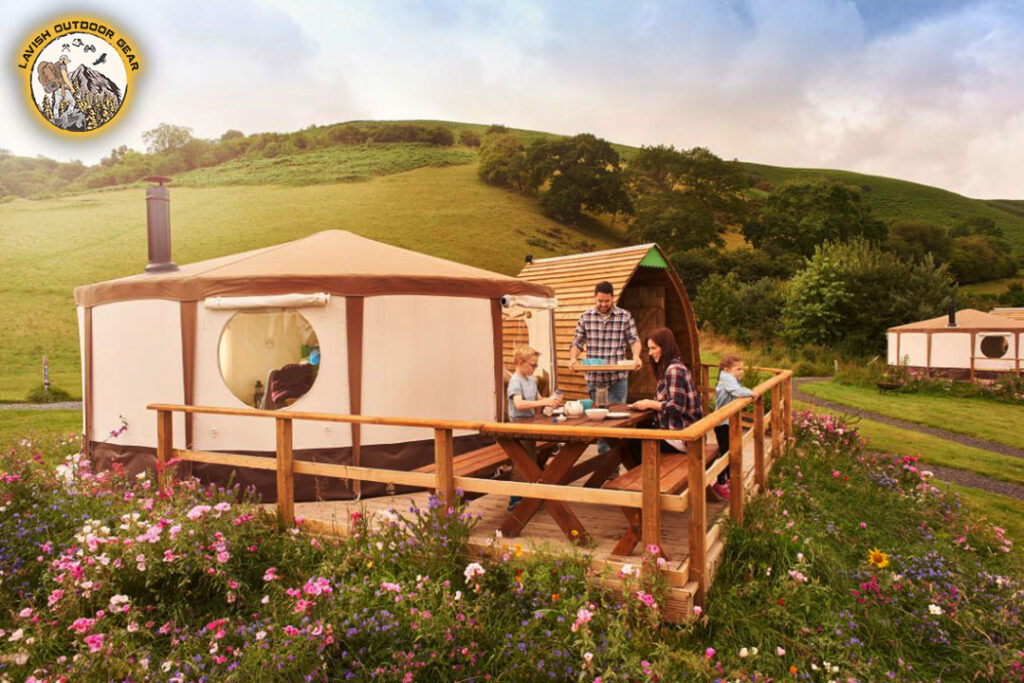
5. Glamping: A Luxurious Way to Experience the Outdoors
Glamping is a luxurious form of camping that combines the comforts of a hotel with the beauty of nature.
Definition and explanation
Glamping, short for glamorous camping, is a form of camping that offers high-end amenities and accommodations. It allows travelers to enjoy the beauty of nature without sacrificing comfort or convenience. Glamping accommodations can range from luxury tents and treehouses to yurts and cabins.
Types of Accommodations for Glamping
There are many types of accommodations available for glamping. The following are some of the most popular:
- Luxury tents: These spacious tents are often furnished with comfortable beds, electricity, and sometimes even en-suite bathrooms.
- Treehouses: Glamping treehouses offer a unique and luxurious experience, with some featuring amenities such as hot tubs and fireplaces.
- Yurts: Yurts are traditional circular structures that can be found all around the world. Modern yurts used for glamping often feature comfortable furnishings, electricity, and heating.
- Cabins: Glamping cabins can range from rustic to modern, and often come equipped with electricity, heating, and indoor plumbing.
Pros and Cons
Glamping has its pros and cons such as
Pros:
- Luxurious accommodations and amenities
- Opportunity to experience nature without sacrificing comfort
- Wide variety of locations and accommodations to choose from
Cons:
- Can be expensive
- May not offer the same sense of adventure as traditional camping
- May not be as eco-friendly as traditional camping
Tips for glamping
Some tips for a successful glamping trip are:
- Research your glamping accommodations ahead of time and make sure you know what amenities are provided.
- Pack clothing appropriate for the weather and activities you have planned.
- Bring any necessary equipment, such as hiking gear or swimwear, to maximize your glamping experience.
- Consider bringing your food and drinks to save money and ensure you have your favorite snacks and beverages.
- Be respectful of the natural environment and follow Leave No Trace principles.
Glamping is a great way to experience the beauty of nature while enjoying luxurious accommodations and amenities. With the right planning and mindset, a glamping trip can be a truly unforgettable experience.

6. RV Camping: A Convenient Way to Explore the Outdoors
It’s a popular form of camping that offers the comfort and convenience of home while enjoying the great outdoors.
Definition and explanation
RV camping involves traveling in a recreational vehicle, or RV, and camping in designated campgrounds or wilderness areas. An RV is essentially a portable home on wheels that can include sleeping quarters, a kitchen, a bathroom, and a living space. RVs can range from small camper vans to large, luxurious motorhomes.
Types of RVs for camping
Several types of RVs are suitable for camping, including
- Class A Motorhomes: These are the largest and most luxurious RVs, typically over 30 feet long, and offer the most amenities and living space.
- Class B Camper Vans: These are smaller RVs built on a van chassis, typically with a raised roof for additional headroom.
- Class C Motorhomes: These are mid-sized RVs, with a cabin over the driving area and sleeping quarters in the back.
- Travel Trailers: These are trailers that are towed behind a vehicle, ranging in size from small pop-up trailers to large fifth-wheel trailers.
Gear Needed for RV Camping
A good RV camping experience depends on having the right gear. Your trip should include the following items:
- RV: Choose the type of RV that best fits your needs based on size, amenities, and budget.
- Bedding and linens: Bring sheets, pillows, and blankets to make your sleeping quarters comfortable.
- Kitchen supplies: Stock your RV kitchen with cookware, dishes, utensils, and food to make meals.
- Bathroom supplies: Bring towels, toilet paper, and toiletries to make your bathroom experience comfortable.
- Outdoor supplies: Include camping chairs, a portable grill, and a cooler for outdoor activities.
Pros and Cons
RV camping has its advantages and disadvantages. Here are some of them:
Pros:
- Comfort and convenience of home while enjoying the great outdoors
- No need to set up a tent or cook over a campfire
- Access to amenities such as electricity, running water, and bathroom facilities
Cons:
- Can be expensive to purchase or rent an RV
- May limit access to more remote or primitive camping areas
- Requires driving and maneuvering a large vehicle
Tips for RV camping
If you’re planning to go RV camping, here are some guidelines to make your trip more enjoyable and stress-free:
- Choose the right RV: Consider the size and amenities of the RV when choosing one for your trip. Rent or buy an RV that fits your needs and is comfortable for your family or group.
- Plan your route: Map out your route ahead of time, and make sure to account for any necessary stops or detours along the way. Consider using a GPS or navigation app to help you stay on track.
- Pack appropriately: Be sure to pack all the necessary supplies for your trip, including food, clothing, and personal items. Check the weather forecast for your destination and pack accordingly.
- Familiarize yourself with the RV: Before hitting the road, take some time to familiarize yourself with the RV and its features. Practice driving and maneuvering the RV in a safe location.
- Be mindful of your environmental impact: RVs can have a significant impact on the environment, so make sure to dispose of trash and waste properly. Use designated dump stations and follow Leave No Trace principles.
- Check and maintain the RV regularly: Keep your RV in good working condition by performing regular maintenance and inspections. This can help prevent breakdowns and ensure a safe and enjoyable trip.
- Choose the right campsites: Look for campsites that are suitable for RVs and offer the amenities you need, such as electric and water hookups. Consider the location and nearby attractions when choosing a campsite.
- Be respectful of your neighbors: RV camping often involves proximity to other campers, so be mindful of noise levels and respect the privacy of your neighbors.
Exploring the great outdoors with the comforts of home can be a versatile and enjoyable experience through RV camping. By selecting the appropriate RV type, making arrangements beforehand, and being conscious of your environmental influence, you can create a safe and unforgettable camping adventure.

7. Rooftop Tent Camping: An Elevated Way to Camp
The Rooftop tent camping is a type of camping that involves setting up a tent on the roof of a vehicle, such as an SUV, truck, or van.
Definition and explanation
Rooftop tent camping is a unique and convenient way to experience the great outdoors. It involves setting up a tent on the roof of your vehicle, allowing you to camp in comfort and style. Rooftop tents are designed to be easy to set up and take down and can be installed on most types of vehicles with roof racks.
Gear needed for rooftop tent camping
Having the appropriate equipment is vital to ensure a pleasant and cozy rooftop tent camping experience. Below are the necessary items to carry with you on your journey:
- Rooftop tent: Choose a rooftop tent that fits your needs based on size, seasonality, and weather conditions.
- Roof rack: Make sure your vehicle has a roof rack that can support the weight of the rooftop tent and any additional gear you bring.
- Sleeping bags and pads: Invest in quality sleeping bags and pads to keep you warm and comfortable during the night.
- Cooking supplies: Bring a portable stove, cooking utensils, plates, cups, and utensils to make meals.
- Food and water: Plan and bring enough food and water for your trip, and bring a water filter or purification tablets in case of emergencies.
- Clothing and footwear: Dress appropriately for the weather and bring sturdy, comfortable footwear for hiking and exploring.
- First aid kit: Bring a basic first aid kit to address minor injuries or illnesses.
- Other necessary supplies: Remember to bring a headlamp or flashlight, insect repellent, sunscreen, and a multi-purpose tool for a better camping experience.
Pros and Cons
Pros:
- Convenient and easy to set up and take down
- The comfortable and stylish camping experience
- Allows you to camp in areas that may not have traditional campsites
Cons:
- Limited space in the tent
- Requires a sturdy roof rack and a vehicle capable of carrying the weight of the tent and gear
- May not be suitable for extreme weather conditions
Tips for rooftop tent camping
You can make your rooftop tent camping trip successful by following these tips:
- Research your campsite ahead of time and make a checklist of the necessary items to pack.
- Practice setting up and taking down your rooftop tent before your trip.
- Pack efficiently to maximize the limited space in the tent.
- Be prepared for unexpected weather or challenges by bringing a backup plan or additional supplies.
- Be mindful of the weight limit of your roof rack and vehicle, and distribute weight evenly.
Rooftop tent camping can be a fun and unique way to experience the great outdoors, as long as you come prepared and approach it with a sense of adventure. With the right gear, knowledge, and attitude, rooftop tent camping can be a memorable experience that you’ll never forget.
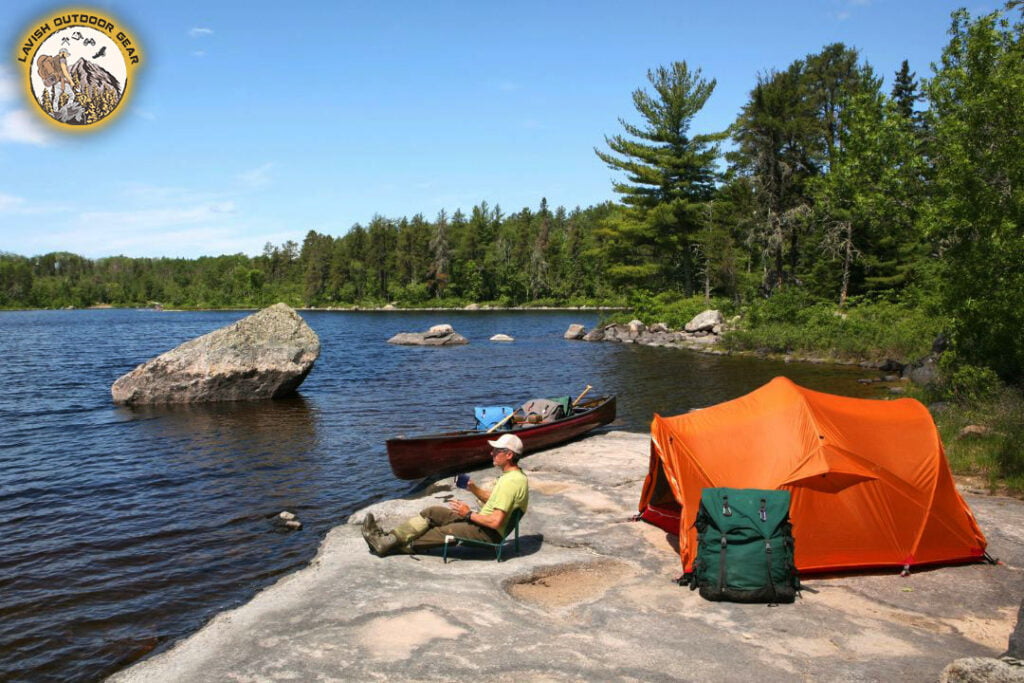
8. Canoe/Kayak Camping: Paddling to Your Campsite
This is the type of camping that involves paddling to a remote location and setting up camp alongside a river or lake.
Definition and explanation
Canoe/kayak camping involves paddling to a remote location and setting up camp alongside a river or lake. It allows for a unique perspective of the wilderness and provides access to secluded areas that are often inaccessible by foot. Canoe/kayak camping requires a certain level of skill and experience in paddling and knowledge of the area and weather conditions.
Gear needed for canoe/kayak camping
To ensure a pleasant and secure canoe/kayak camping trip, it is crucial to have the appropriate gear, such as:
- Canoe/Kayak: Choose a durable, stable canoe or kayak appropriate for the type of water you’ll be paddling, and ensure it’s equipped with the necessary safety gear.
- Paddles: Bring one or two lightweight, sturdy paddles per person.
- Life jackets: Wear properly fitted, US Coast Guard-approved life jackets at all times while on the water.
- Tent: Choose a lightweight, waterproof tent appropriate for the size of your group.
- Sleeping bag and pad: Invest in quality, lightweight sleeping gear to keep you warm and comfortable during the night.
- Cooking supplies: Bring a lightweight stove, cooking utensils, plates, cups, and utensils to make meals.
- Food and water: Plan and bring enough lightweight, non-perishable food and water for your trip, and bring a water filter or purification tablets in case of emergencies.
- Clothing and footwear: Dress in layers appropriate for the weather and bring sturdy, comfortable footwear for exploring on land.
- First aid kit: Bring a comprehensive first aid kit to address injuries or illnesses on the water or land.
- Other necessary supplies: Include a map and compass, sunscreen, insect repellent, and a multi-purpose tool.
Pros and Cons
Canoe/kayak camping has its advantages and disadvantages like
Pros:
- Opportunity to explore remote and secluded areas of wilderness
- Unique perspective and appreciation of nature and wildlife
- Physical exercise and a chance to improve fitness
Cons:
- Requires a certain level of skill and experience in paddling and knowledge of the area
- Exposure to changing weather conditions and water hazards
- Limited amenities and comfort
Tips for canoe/kayak camping
Listed below are some tips for having a great canoe/kayak camping trip:
- It is important to conduct research on your waterway and campsites in advance to check for any necessary permits or regulations.
- Before embarking on your trip, it’s wise to practice paddling and handling your gear in calm, shallow water.
- Plan your route and pace according to your skill level and the current weather conditions.
- Always wear a life jacket while on the water and remain aware of water hazards such as rapids, currents, and rocks.
- To prevent capsizing, pack all gear and supplies in waterproof bags or containers and secure them within the canoe or kayak.
- It is essential to respect the environment and wildlife by following Leave No Trace principles, which include avoiding any damage to vegetation or disturbance of wildlife.
Canoe/kayak camping can be an unforgettable and rewarding way to experience the great outdoors, as long as you come prepared and approach it with respect for the water, environment, and your limitations. With the right gear, knowledge, and attitude, canoe/kayak camping can be a life-changing experience that you’ll never forget.
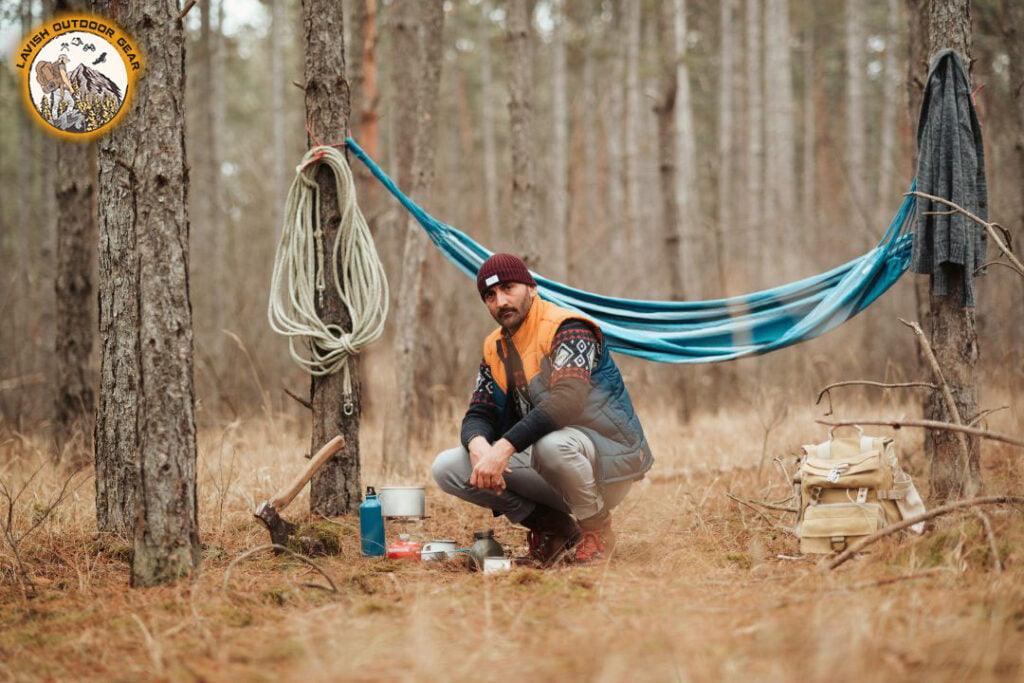
9. Stealth/Survival Camping: Thriving in the Wild
Stealth/Survival camping, also known as wild camping, is a type of camping that involves finding a hidden, remote location and camping without being detected. This type of camping is typically done in areas where camping is not allowed, or in places where the camper wants to avoid the crowds and noise of traditional campsites.
Definition and explanation
Stealth/Survival camping is a type of camping that involves finding a remote location that is not an established campsite and camping without being detected. It often involves carrying minimal gear and relying on survival skills to make shelter, find food, and survive in the wilderness. It requires a high level of outdoor skills and knowledge to camp safely and sustainably.
Gear needed for stealth/survival camping
Presented below are some of the necessary items for survival camping to bring with you.
- Lightweight backpack: Choose a backpack that is lightweight and comfortable to wear.
- Portable shelter: Bring a lightweight, portable shelter such as a tarp or bivy sack to provide shelter from the elements.
- Sleeping bag and pad: Invest in quality, lightweight sleeping gear to keep you warm and comfortable during the night.
- Water filtration or purification system: Bring a water filter or purification tablets to make sure you have access to clean drinking water.
- Minimal cooking supplies: Bring a lightweight stove, cooking pot, and utensils to cook food, or rely on non-cook meals.
- First aid kit: Bring a comprehensive first aid kit to address injuries or illnesses in the wilderness.
- Multi-purpose tool: Bring a knife or multi-purpose tool to help with shelter building, food gathering, and other survival tasks.
- Firestarter: A reliable firestarter, such as waterproof matches or a lighter, is essential for cooking food and staying warm.
- Personal protection items: Items like bear spray, pepper spray, and a whistle can be helpful for personal protection in case of an emergency.
- Other necessary supplies: Include a headlamp or flashlight, map and compass, insect repellent, sunscreen, and a signaling device such as a whistle or mirror.
Pros and Cons
Pros:
- Opportunities for solitude and connection with nature
- Chance to learn and practice survival skills
- Avoiding crowds and fees of traditional campsites
Cons:
- Legality issues: Stealth/Survival camping is often illegal and can result in fines or other penalties.
- Safety concerns: Camping in remote areas without amenities or cell phone service can be risky.
- Lack of comfort: Requires you to rely on minimal gear and may involve discomfort or exposure to the elements.
Tips for stealth/survival camping
If you’re planning on stealth/survival camping, you’ll need to be well-prepared with the right gear to ensure your safety and comfort. Here are some essential items you should consider:
- Research the legalities of the area and make sure Stealth/Survival camping is allowed.
- Choose a remote location that is far away from trails and people to avoid detection.
- Make sure to leave no trace by packing out all trash and burying human waste.
- Bring a map and compass and practice navigation skills before your trip.
- Learn and practice survival skills such as fire building, shelter construction, and food gathering.
- Always be prepared for unexpected weather or emergencies by bringing backup supplies and a way to signal for help.
Experiencing the great outdoors through stealth/survival camping can be a fulfilling and challenging adventure if approached with caution and a sense of excitement. With the right attitude, equipment, and expertise, this form of camping can be a life-altering experience that will stay with you forever.
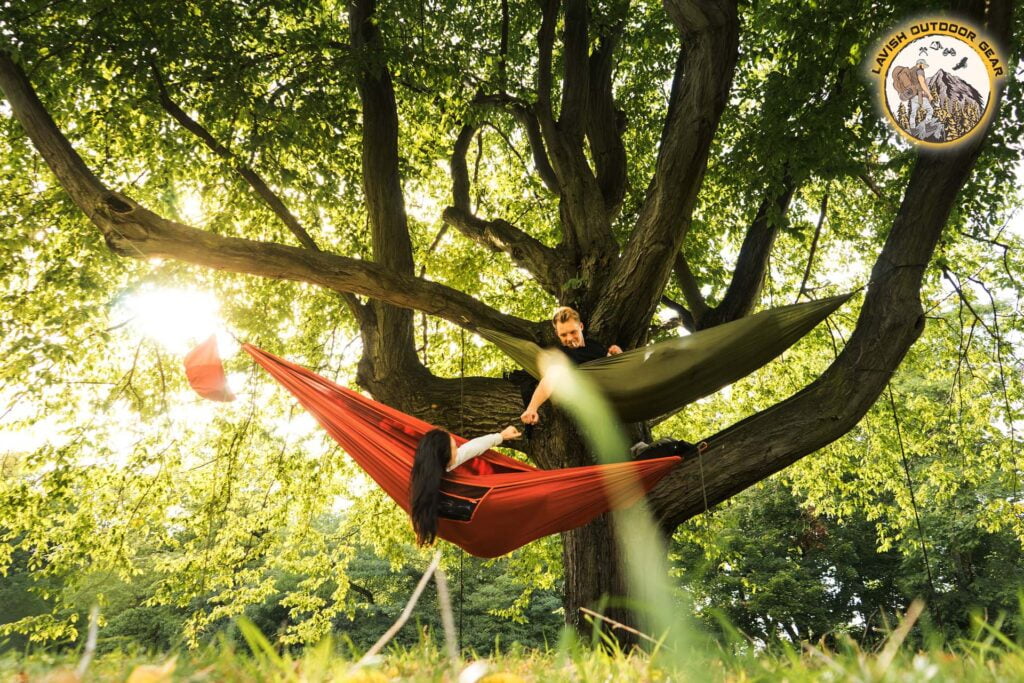
10. Hammock Camping: Swinging in the Great Outdoors
It is an increasingly popular form of camping that involves using a hammock as the primary shelter for sleeping.
Definition and explanation
Hammock camping involves sleeping in a hammock, typically suspended between two trees, as an alternative to a traditional tent. It is a lightweight and compact form of camping that can provide a comfortable and unique sleeping experience.
Gear needed for hammock camping
Having the appropriate gear is crucial, and the following are some essential items that you should bring on your trip:
- Hammock: Choose a durable, high-quality hammock that is designed for camping and is appropriate for the weather conditions you’ll encounter.
- Suspension system: Invest in a reliable suspension system, such as straps or ropes, that will keep your hammock secure and at a comfortable height.
- Tarp: Bring a tarp or rainfly to protect yourself and your gear from rain and wind.
- Sleeping bag or quilt: Choose a lightweight and compressible sleeping bag or quilt that is appropriate for the expected temperatures.
- Insulation: Depending on the weather conditions, you may need additional insulation, such as an underquilt or pad, to keep you warm.
- Bug net: Consider bringing a bug net to protect you from insects while you sleep.
- Other necessary supplies: Include a headlamp or flashlight, map and compass, insect repellent, sunscreen, and a multi-purpose tool.
Pros and Cons
Pros:
- Lightweight and compact, making it easy to transport and set up
- Comfortable and unique sleeping experience
- Versatile, as hammocks can be set up in a variety of locations
Cons:
- Limited space and may not be ideal for groups or larger individuals
- Requires a good understanding of properly setting up and adjusting the hammock and suspension system
- May not be suitable for all weather conditions, as additional insulation and protection may be necessary
Tips for hammock camping
Some important tips for making a hammock camping trip memorable:
- Practice setting up and adjusting your hammock and suspension system before your trip.
- Choose a suitable location that has appropriate trees or structures to hang your hammock.
- Bring additional insulation, such as an under quilt or pad, to stay warm in colder temperatures.
- Consider bringing a lightweight camping chair or stool for additional seating and comfort.
- Be mindful of Leave No Trace principles and follow all regulations and guidelines for your chosen camping location.
Hammock camping can be a comfortable and unique way to experience the great outdoors. With the right gear and knowledge, hammock camping can provide a refreshing and enjoyable escape from the stresses of daily life.
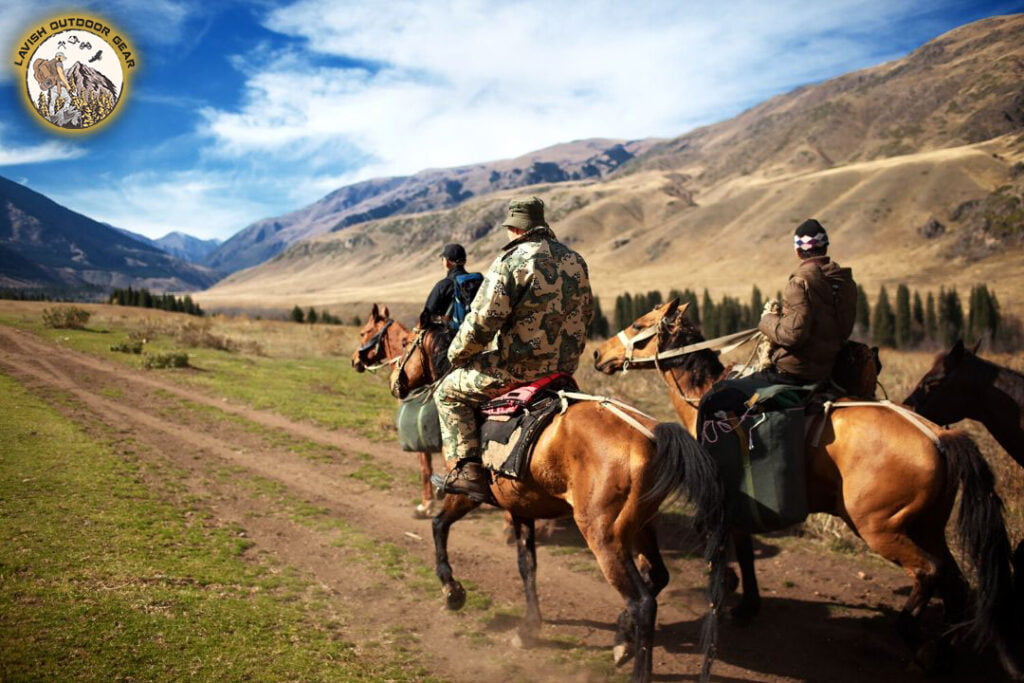
11. Horseback Camping: Exploring the Wilderness on Horseback
It’s a form of camping that involves using horses as a means of transportation and packing animals to carry camping gear and supplies.
Definition and explanation
Horseback camping involves using horses to access remote wilderness areas and carrying camping gear and supplies on horseback. It provides a unique opportunity to explore the outdoors and experience a traditional form of travel that has been used for centuries.
Gear needed for horseback camping
Here is a list of essential items that you should bring on your horseback camping trip:
- Horse: Choose a well-trained, reliable horse that is appropriate for the rider’s size and experience level.
- Tack: Invest in high-quality horse tacks, such as a saddle, bridle, and reins, that fit the horse properly and are comfortable for both the horse and rider.
- Camping gear: Bring lightweight and compact camping gear, including a tent, sleeping bag, cooking supplies, and food, that can be easily transported on horseback.
- First aid kit: Include a well-stocked first aid kit that includes supplies for both horse and rider.
- Navigation tools: Bring a map and compass, GPS device, or other navigation tools to help you stay on course.
- Other necessary supplies: Include water filtration or purification supplies, insect repellent, sunscreen, and a multi-purpose tool.
Pros and Cons
Pros:
- Provides access to remote wilderness areas that may be difficult or impossible to reach on foot
- Allows for efficient transport of camping gear and supplies
- Provides a unique and traditional form of travel and camping experience
Cons:
- Requires prior experience with horses and proper training to ensure safety for both horse and rider
- May require a higher level of physical fitness for riders
- May be more expensive than traditional backpacking or car camping due to the cost of owning or renting a horse
Tips for horseback camping
Some tips to make your horseback camping trip successful:
- Take time to properly train and prepare both the horse and rider before the trip.
- Pack and balance gear and supplies evenly on both sides of the horse to ensure a comfortable ride and prevent injury.
- Choose a campsite that has access to water and sufficient space for the horses to graze.
- Follow Leave No Trace principles and properly dispose of all waste and trash.
- Respect wildlife and avoid disturbing natural habitats.
Horseback camping is a distinctive and fulfilling approach to exploring the natural world. By equipping oneself with appropriate gear, preparing thoroughly, and possessing adequate knowledge, horseback camping can result in an unforgettable expedition in the great outdoors.
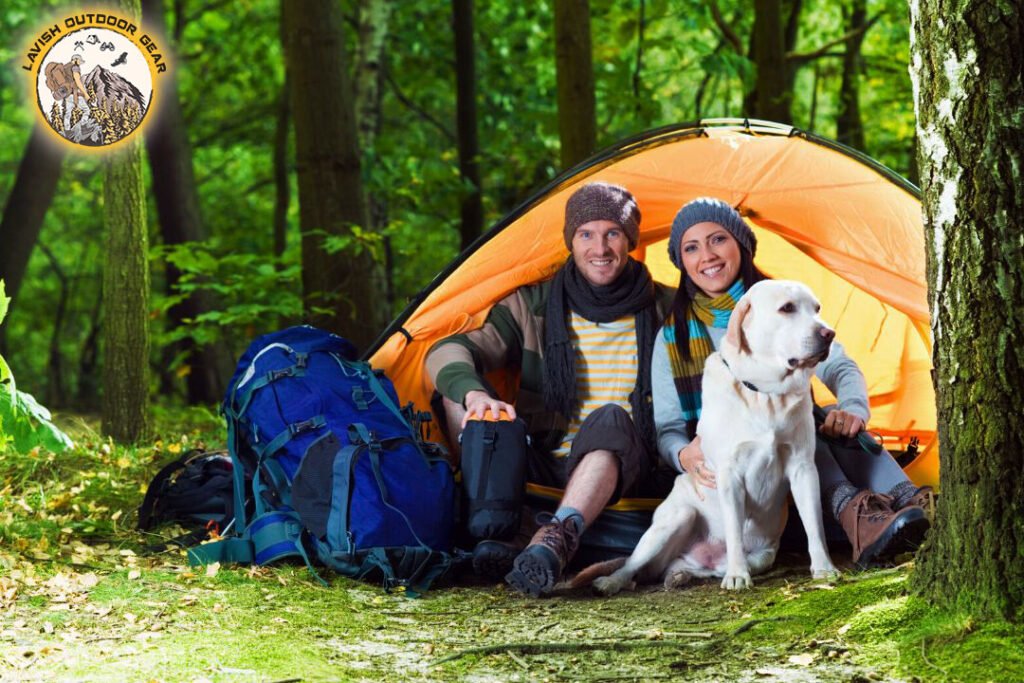
12. Pet Camping: Exploring the Outdoors with Your Furry Friend
Pet camping is a type of camping that involves bringing your furry companion with you on your outdoor adventure.
Definition and explanation
It is a type of outdoor recreation where pet owners bring their pets along for the camping experience. This could be anything from a weekend camping trip to a longer vacation in the great outdoors.
Gear and preparation needed for camping with pets
To make your pet camping experience enjoyable and safe for both you and your pet, it’s important to have the right gear and preparation. Here are some essential items and things to consider before your trip:
- Pet-friendly campsite: Make sure the campsite you choose allows pets, and be aware of any specific rules or regulations.
- Leash and collar: Bring a leash and collar for your pet, even if they’re well-behaved, to keep them safe and under control.
- Food and water: Bring plenty of food and water for your pet, as well as bowls for them to eat and drink from.
- Bedding: Bring a comfortable bed or pad for your pet to sleep on.
- First aid kit: Bring a pet-specific first aid kit, including any medication your pet may need.
- Toys and treats: Bring toys and treats to keep your pet entertained and happy.
- Training: Ensure your pet is well-trained and obedient to avoid any safety concerns or conflicts with other campers.
Pros and cons
Pros:
- The opportunity to spend quality time with your pet in the great outdoors
- The chance for your pet to exercise and explore new surroundings
- Enhanced security, as your pet, can act as an early warning system and help protect your campsite
Cons:
- Potential for conflict with other campers and their pets
- Additional responsibilities, such as cleaning up after your pet and keeping them under control
- Possible exposure to wildlife and other environmental hazards
Tips for pet camping
Here are some tips for a great pet camping tour:
- Make sure your pet is up-to-date on all their vaccinations and has any necessary medication.
- Keep your pet on a leash and under control at all times, especially when close to other campers or wildlife.
- Bring a pet-specific first aid kit and be prepared to handle any emergencies.
- Pack out all pet waste and dispose of it properly.
- Respect other campers and their space, and be mindful of your pet’s behavior.
Camping with your pet can be a fulfilling and memorable adventure that you and your furry friend can cherish. Proper equipment and preparation will enable you to relish the beauty of nature together and make indelible reminiscences.
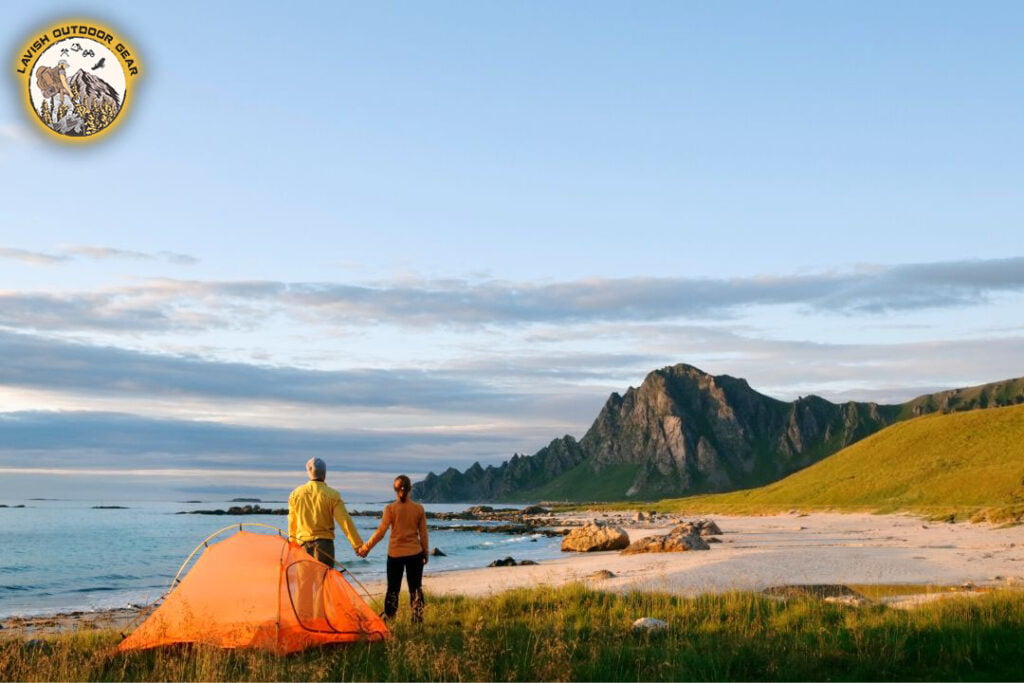
13. Beach Camping: A Serene Way to Enjoy the Ocean
It’s a popular form of outdoor recreation that involves setting up camp on a beach.
Definition and explanation
Camping on a beach involves setting up a tent or other shelter on a beach, typically near the water’s edge. It is a unique and relaxing way to experience the natural beauty of the beach and can provide a fun and memorable experience for families, couples, or solo adventurers.
Gear needed for beach camping
To make your beach camping experience enjoyable and safe. Here are some important items and factors to consider before your trip:
- Tent or shelter: Choose a tent or other shelter that is appropriate for the weather conditions and the number of people in your group.
- Sleeping gear: Bring sleeping bags, blankets, and pillows to ensure a comfortable night’s sleep.
- Beach gear: Bring beach chairs, towels, and other gear for lounging and enjoying the beach.
- Cooking gear: Bring a portable stove or grill, pots and pans, utensils, and other cooking gear for preparing meals.
- Food and water: Bring plenty of food and water for your trip, as well as a way to store and transport it.
- Sun protection: Bring sunscreen, hats, and sunglasses to protect yourself from the sun.
- Other necessary supplies: Include a first aid kit, insect repellent, a flashlight, and a multi-purpose tool.
Pros and Cons
Pros:
- Unique and beautiful scenery
- Relaxing and peaceful atmosphere
- Opportunities for swimming, fishing, and other beach activities
Cons:
- Limited access to amenities, such as running water and toilets
- May be affected by weather conditions, such as high winds and tides
- May be crowded during peak season and holidays
Tips for beach camping
Below are some recommendations for a prosperous camping experience on the beach:
- Check local regulations and permits for beach camping in your chosen location.
- Choose a location that is safe and accessible, with adequate space for your group.
- Check the weather forecast and prepare accordingly, including bringing appropriate clothing and gear.
- Bring a beach umbrella or other shade structure to protect yourself from the sun.
- Be mindful of beach wildlife, such as nesting sea turtles and shorebirds, and follow all regulations and guidelines for their protection.
Beach camping can be a unique and enjoyable way to experience the outdoors. With the right gear and preparation, you can have a memorable and relaxing trip on the beautiful beaches of the world.

14. Group Camping: Enjoying the Outdoors with Friends and Family
Group camping is an enjoyable and rewarding activity that involves camping with a group of people. Whether it’s with family, friends, or a club, group camping is an excellent way to share experiences, create memories, and enjoy the great outdoors together.
Definition and explanation
This type of camping is an outdoor activity that involves camping with a group of people, typically in a designated camping area. Group camping allows individuals to share their camping experiences and enjoy the great outdoors together, creating memories that will last a lifetime. It can be done in a variety of camping styles, from traditional tent camping to RV camping and glamping.
Benefits of group camping
It has numerous benefits that make it a popular and enjoyable activity. Some of these benefits include
- Shared experiences: Camping with others allows you to share experiences and create memories together, strengthening bonds and creating a sense of community.
- Cost-effective: Group camping can be a cost-effective way to camp since the cost of campsites, gear, and other expenses can be shared among the group.
- Safety: Camping in a group provides an added layer of safety, as there are more people to help in case of an emergency.
- Learning opportunity: Group camping provides an excellent opportunity to learn new skills, share knowledge, and gain new insights from others.
- Enhanced enjoyment: Group camping provides a greater sense of enjoyment, as there are more people to share the experience with and to participate in activities together.
Tips for planning and enjoying a group camping trip
To plan and enjoy a successful group camping trip, it’s important to keep in mind some key tips given below:
- Set clear expectations: It’s important to communicate expectations and goals for the trip with the group beforehand. This can include expectations around activities, schedules, and general guidelines for behavior.
- Choose the right location: Select a location that is appropriate for the group’s size, interests, and abilities. Consider factors such as accessibility, activities, facilities, and proximity to amenities.
- Plan activities: Planning activities that the group can enjoy together is an important aspect of group camping. This can include outdoor activities such as hiking, swimming, and fishing, or indoor activities such as board games and storytelling.
- Share responsibilities: Assigning responsibilities such as meal preparation, cleanup, and activities can help ensure that everyone is involved and that the workload is shared.
- Respect personal space: While group camping is about sharing experiences, it’s also important to respect each other’s personal space and needs.
- Be prepared for the unexpected: Plan for unexpected situations such as weather changes, emergencies, or injuries. Have a plan in place for dealing with unexpected situations and make sure everyone in the group is aware of the plan.
To summarize, group camping is a pleasurable and advantageous pursuit that offers various advantages. By adhering to these guidelines for organizing and savoring a group camping excursion, you can guarantee a delightful and unforgettable encounter for all the participants.

15. Desert Camping: Experiencing the Beauty of the Arid Wilderness
Desert camping is a unique and adventurous way to explore the arid regions of the world.
Definition and Explanation
Desert camping involves setting up camp in a dry and barren environment, where the temperatures can vary significantly from day to night. It is a challenging form of camping that requires careful planning, preparation, and a good understanding of the unique conditions that you’ll encounter in the desert.
Gear Needed for Desert Camping
Proper gear is crucial for a safe and enjoyable desert camping experience. Check out the list below:
- Tent: Choose a high-quality tent that is designed for desert camping and can withstand the wind and sand.
- Sleeping bag: Bring a sleeping bag that is appropriate for the expected temperatures, and consider bringing a liner to protect yourself from the sand and wind.
- Sun protection: Bring a hat, sunglasses, and sunscreen to protect yourself from the intense sun and UV radiation.
- Water: Bring plenty of water and a way to purify more if necessary. The rule of thumb is to carry at least one gallon of water per person per day.
- Food: Bring non-perishable and easy-to-prepare meals, such as canned goods and dry snacks.
- Navigation tools: Bring a map, compass, and GPS to help you navigate through the desert.
- Emergency supplies: Bring a first aid kit, whistle, signal mirror, and a satellite phone or other means of communication in case of emergency.
Pros and Cons
Some of the pros and cons are:
Pros:
- Unique and unforgettable scenery and landscapes
- Opportunities for stargazing and astrophotography
- Less crowded than other camping locations
Cons:
- Extreme temperatures can vary significantly between day and night
- Limited water sources and access to amenities
- High risk of dehydration and sunburn
Tips for Desert Camping
Here are some recommendations for a thriving camping trip in the desert:
- Before camping, conduct thorough research on the location to identify potential hazards such as flash floods, poisonous plants and insects, and wildlife.
- Avoid setting up camp in low-lying areas or washes that may be vulnerable to flooding during heavy rainfall.
- Schedule your camping trip during the cooler months of the year to avoid extreme temperatures.
- Refrain from engaging in strenuous activities during the hottest parts of the day and seek shade as much as possible.
- Ensure you remain hydrated by drinking water regularly, even if you do not feel thirsty.
- Follow the principle of “leave no trace” by packing out all of your trash and waste.
For daring and well-equipped campers, camping in the desert can be an arduous yet fulfilling endeavor. By possessing the appropriate gear and expertise, you can investigate the exclusive splendor and seclusion of the desert while ensuring your safety and comfort.
16. Family Camping: Creating Lifelong Memories in the Great Outdoors
Family camping is an excellent way for families to spend quality time together in nature, away from the distractions of daily life.
Definition and Explanation
Family camping is an outdoor activity that involves families camping together in a tent, cabin, or RV. It is a great way for families to bond and spend quality time together in a natural setting.
Benefits of Family Camping
Family camping has many benefits, including
- Quality family time: Camping allows families to spend time together without the distractions of daily life, such as technology and work.
- Outdoor recreation: Camping provides families with opportunities for outdoor activities, such as hiking, fishing, and swimming.
- Improved health: Spending time in nature can help reduce stress, improve mood, and increase physical activity.
- Learning opportunities: Camping provides families with opportunities to learn new skills, such as setting up a tent, building a campfire, and identifying plants and wildlife.
Tips for Planning and Enjoying a Family Camping Trip
Listed below are some tips to help families plan and enjoy a great tour:
- Choose the right location: Consider the needs and interests of all family members when choosing a camping location. Look for a campground with amenities that are important to your family, such as showers, playgrounds, and picnic areas.
- Plan for comfort and safety: Make sure to bring appropriate gear and equipment, such as comfortable sleeping bags and a first aid kit. Consider bringing extra blankets, pillows, and clothing layers to stay warm at night.
- Involve children in planning: Let children help plan the camping trip by choosing activities and meals. This can help get them excited about the trip and provide opportunities for learning and skill development.
- Bring entertainment: Consider bringing games, books, and other activities to keep children entertained during downtime.
- Be prepared for inclement weather: Check the weather forecast before leaving and pack appropriate gear, such as raincoats and extra tarps, to stay dry in case of rain.
- Practice Leave No Trace principles: Encourage children to respect the environment by practicing Leave No Trace principles, such as packing out trash and not disturbing wildlife.
Family camping is a great way to bond with loved ones and create lasting memories. With the right planning and preparation, a family camping trip can be an enjoyable and rewarding experience for everyone.

17. Snow Camping: An Adventure in the Winter Wilderness
Snow camping is a form of winter camping that involves setting up camp in a snowy environment and spending one or more nights outdoors.
Definition and explanation:
Snow camping is a unique way to experience the winter wilderness and enjoy the beauty of the snowy landscape. It involves all of the same elements of traditional camping, such as shelter, food, and clothing, but with the added challenges of cold temperatures, snow, and potential hazards such as avalanches. Snow camping can be done in a variety of winter environments, from snowy forests to alpine terrain, and requires a high level of outdoor skills and equipment.
Gear needed for snow camping:
Snow camping requires a specific set of gear to ensure safety and comfort in the winter environment, including the following:
- Tent: Choose a durable and waterproof tent that is appropriate for winter weather conditions.
- Sleeping bag and pad: Bring a high-quality sleeping bag and pad that can keep you warm in below-freezing temperatures.
- Stove: Bring a stove and fuel to melt snow for drinking water and cooking meals.
- Food and water: Plan and bring enough food and water for your trip, and bring a water filter or purification tablets in case of emergencies.
- Clothing and footwear: Dress in warm, waterproof layers appropriate for the cold and snowy conditions, and bring sturdy, insulated boots with good traction.
- First aid kit: Bring a comprehensive first aid kit that includes supplies for treating hypothermia, frostbite, and other winter-related injuries.
- Avalanche safety equipment: If traveling in avalanche terrain, bring a shovel, probe, and avalanche beacon, and know how to use them.
- Other necessary supplies: Include a headlamp or flashlight, map and compass, sunscreen, and a multi-purpose tool.
Pros and cons:
Snow camping has its advantages and disadvantages as follows:
Pros:
- Opportunity to experience the beauty of the winter wilderness and enjoy winter activities such as snowshoeing and cross-country skiing
- Sense of adventure and self-reliance
- Unique challenges that can help build outdoor skills and resilience
Cons:
- Requires a high level of physical fitness and outdoor skills
- Exposure to extremely cold temperatures, snow, and potential hazards such as avalanches
- Limited amenities and comfort
Tips for snow camping:
Some tips for a successful snow camping trip are as follows:
- Conduct preliminary research on the winter camping location and create a packing checklist for necessary items.
- Before embarking on the trip, practice erecting your tent and stove in a winter environment.
- Bring additional layers of warm, waterproof clothing along with snowshoes or skis for traversing through the snow.
- Check the avalanche forecast and chart out your path accordingly.
- Consume high-calorie foods and stay hydrated to maintain body warmth.
- Prepare for unforeseen weather or obstacles by packing backup supplies or devising a contingency plan.
Snow camping can be a challenging and rewarding way to experience the winter wilderness, as long as you come prepared and approach it with a sense of adventure. With the right gear, knowledge, and attitude, snow camping can be an unforgettable experience.
How to Choose the Right Type of Camping
Choosing the right type of camping can make a big difference in the overall enjoyment of your outdoor experience. There are several factors to consider when deciding which type of camping is right for you.
Personal preferences
Your personal preferences and interests should play a major role in the type of camping you choose. If you enjoy the rugged wilderness and challenging hikes, backpacking may be the best option for you.
If you prefer a more luxurious experience, glamping may be the way to go. Think about what you enjoy doing and what you want to get out of your camping experience.
Budget
Your budget will also be a significant factor in your decision. Some forms of camping, such as backpacking, can be very affordable, while others, such as glamping, can be quite expensive. Consider your budget and how much you are willing to spend on accommodations, gear, and other expenses.
Group size
The size of your group will also affect your decision. Some forms of camping, such as RV camping, are ideal for larger groups, while others, such as backpacking, may be better suited for smaller groups. Consider the size of your group and the accommodations and gear that will be needed for everyone.
Accessibility
The size of your group will also affect your decision. Some forms of camping, such as RV camping, are ideal for larger groups, while others, such as backpacking, may be better suited for smaller groups. Consider the size of your group and the accommodations and gear that will be needed for everyone.
Duration of stay
The length of your camping trip will also play a role in your decision. If you plan to stay for an extended period, RV camping or glamping may provide a more comfortable and sustainable experience. If you only have a short amount of time, tent camping or backpacking may be the best options to maximize your time and experience.
Importance of choosing the right type of camping
It is important to choose the right type of camping for a variety of reasons. It can affect the overall enjoyment of your camping experience, as well as your budget, group size, accessibility, and duration of stay. By considering all of these factors, you can choose the type of camping that best suits your needs and preferences.
Conclusion
Camping is a gateway to unforgettable experiences and can be enjoyed in many different ways. From tent camping to RV camping, backpacking, and glamping, there are many different types of camping to choose from. Each type of camping has its advantages and disadvantages, and it’s important to choose the type that best suits your personal preferences, budget, group size, accessibility, and duration of stay.
We have a detailed “12 Types of Camping Tents” guide, you may take a look for a better understanding of the tent types. We hope our guide has helped you understand the various types of camping. We try our best to provide you with knowledge about outdoor activities, especially Camping, and backpacking, and guides to Outdoor Gear.
Keep supporting us if you find our content useful because it will keep Us motivated to give you such valuable information and guides!
Faqs
Q. What gear do I need for tent camping?
The essential gear for tent camping includes a tent, sleeping bag, sleeping pad, camping stove, cookware, and a headlamp or flashlight.
Q: What are the 3 most popular types of camping?
The three most popular types of camping are car camping, tent camping, and RV camping.
Q: What are some camping skills?
Some essential camping skills include setting up a tent, starting a fire, cooking over an open flame, navigating with a map and compass, and basic first aid.
Q: What is survival camping?
Survival camping is a type of camping where the focus is on self-reliance, primitive skills, and surviving in the wilderness with minimal gear and resources.
Q. What is Backpacking and how is it different from Regular Camping?
Backpacking involves hiking to camp with a backpack for remote experiences. Regular camping is setting up at a campground with a vehicle, offering more amenities.
Q. What are the essential differences between Car Camping and RV Camping?
Car camping is mobile, using a tent or car for simplicity. RV camping uses a vehicle with living amenities for a more comfortable experience.
Q. What’s the difference between Frontcountry Camping and Backcountry Camping?
Frontcountry camping is at accessible sites with amenities, while backcountry camping involves venturing into remote areas, requiring hiking for a rugged experience.

